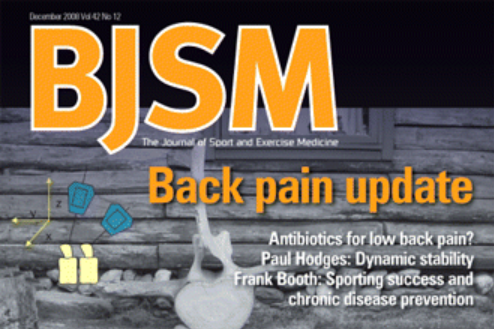 It is not often that something I read in the medical research literature gives me goosebumps and an incredible urge to tell everyone I know about it (thank god for Twitter!). I had that feeling today when, after an article in this morning’s Guardian newspaper, I read two recent papers published by a Danish group of researchers led by Hanne Albert in the European Spine Journal (links below).
It is not often that something I read in the medical research literature gives me goosebumps and an incredible urge to tell everyone I know about it (thank god for Twitter!). I had that feeling today when, after an article in this morning’s Guardian newspaper, I read two recent papers published by a Danish group of researchers led by Hanne Albert in the European Spine Journal (links below).
Infection and low back pain!?
The papers relate to the possibility of an infective cause in a sub-group of patients with chronic low back pain. This sub-group is those patients with Modic changes. Modic changes (MC) are bone oedema in the adjoining vertebra to one in which there is a disc herniation. MC are present in 46% of patents with chronic low back pain compared to 6% in the general population. MC can only be reliably detected using MR imaging. A number of previous studies have demonstrated the presence of bacteria especially Propionbacterium acnes (P. acnes) in disc nucleus tissue evacuated at surgery from patients with lumbar disc herniation.
The first paper Does nuclear tissue infected with bacteria following disc herniations lead to Modic changes in the adjacent vertebrae? reports on 61 patients who had nuclear disc material removed while undergoing surgery for chronic low back pain. Microbiological cultures were positive in 28 (46%) patients, of which 26/28 were anaerobic cultures, 2 (3%) aerobic and 4 (7%) mixed. In the discs with a nucleus with anaerobic bacteria present, 80% developed MC in the vertebrae adjacent to the previous disc herniation, compared to none in the aerobic group and 44% with negative cultures. They concluded that the occurrence of MCs in the vertebrae adjacent to a previously herniated disc may be due to oedema surrounding an infected disc.
How do intervetebral discs become infected?
Organisms such as P. acnes are commonly found in hair follicles in the skin and in the oral cavity. They frequently invade the circulatory system during tooth brushing where they do not present an immediate risk because the blood stream is an aerobic environment. When an intervertebral disc is herniated, nuclear material extrudes into the spinal canal. Within a short time, neocapillarisation begins in and around the extruded nucleus material, inflammation occurs and brings with it macrophages. So far so good – no debate about any of that.
The innovation of the authors is their proposal that avascular and thus anaerobic disc provides an ideal environment for these anaerobic bacteria to flourish. In this setting, anaerobic bacteria that are normally inconsequential (low virulent) may enter the disc and give rise to a slowly developing infection.
Local inflammation in the adjacent bone (MC Type 1) may be a secondary effect due to cytokine production or microbial metabolites (e.g. propionic acid) entering the vertebrae through normal disc nutrition. P. acnes is known from the skin to trigger an adjacent inflammatory response. P. acnes cannot multiply in the highly vascular aerobic bone and are therefore not present where the MC occur.
All good in theory but what about an RCT?
The second paper is entitled Antibiotic treatment in patients with chronic low back pain and vertebral bone edema (Modic type 1 changes): a double-blind randomized clinical controlled trial of efficacy. this paper reports the efficacy of antibiotic treatment in this group of patients with MC lesions and chronic low back pain. This double blind RCT study examined 162 patients with chronic low back pain (> 6 months duration) occurring after a previous disc herniation AND who had MC changes in the vertebrae adjacent to the previous herniation. Subjects were randomised to either 100 days of antibiotic treatment (Bioclavid) of two different dosages or placebo. Outcomes were evaluated at baseline, end of treatment and at 1 year follow up.
Primary outcomes were the well accepted disease-specific disability Roland Morris Questionnaire as well as the report of lumbar pain. The antibiotic group made highly statistically significant improvements on all outcome measures; the improvement continued from 100 days follow up until 1 year follow up. For example, on the disease specific disability, the antibiotic group was 15 at baseline, 11 at 100 days and 5.7 at 1 year compared to placebo (15, 14, 14). The report of lumbar pain decreased much more in the antibiotic group who started at a score of 6.7 and improved to scores of 5.0 (100 days) and 3.7 (1 year). The placebo group mean report of lumbar pain stayed constant at 6.3 from baseline through 100 days and 1 year (lower is better, of course).
Biologically plausible time course
Patients also reported that pain relief and improvement in disability commenced gradually, for most patients 6-8 weeks after the start of the antibiotic tablets and for some at the end of the treatment period. Improvements reportedly continued long after the end of the treatment period, at least for another 6 months, and some patients reported continuing improvement at 1-year follow up. The improvement seen in the antibiotic group at 1 year follow up was approximately twice that observed at the end of the 100 day treatment period, suggesting that a biological healing process that starts only when and after the bacteria have been killed.
Half the treatment group took one Bioclavid (amoxycillin-clavulanate 500mg/125mg) tablet three times a day while the other half took two tablets. The authors state that the long duration of antibiotic treatment is commonly prescribed for post-operative discitis. There was a trend towards an improvement with double dose, but did not reach significance.
What should we make of these papers?
This treatment is certainly an exciting possibility for one of the most difficult management challenges in medicine. At this stage all the authors are saying is that in a particular sub-group of patients with chronic (>6 months) low back pain, those with Modic changes on MRI scan after lumbar disc herniation may respond well to long term antibiotic treatment. We are reluctant to prescribe long term antibiotics for reasons of potential development of resistance but there seems to be a rationale for long term use in this situation. Further studies need to assess the efficacy of shorter terms of treatment. Because this is the BJSM blog, we can point out to readers that the group’s pilot study was not accepted by a number of famous journals but saw the light of day via BJSM’s ‘peer-review fair review’ process. That paper came out in 2008.
I would think on the basis of this research it is reasonable to prescribe the recommended antibiotic program to those who strictly meet the clinical and MR imaging criteria. Especially if the only alternative seems to be surgery which has limited efficacy in these patients and is obviously vast more expensive than a course (albeit prolonged) of antibiotic therapy. Remember if you have this infection surgery will not be treating the cause.
It took the Nobel prize winning research on Heliobacter and its relationship to stomach ulcers of West Australians Barry Marshall and Robin Warren to alert the skeptical medical community of the potential of infective causes of common conditions. Many investigators are currently seeking infective causes for a wide variety of common and uncommon medical disorders. This research will encourage such investigation. Undoubtedly we will find more causal infective relationships. Further work needs to be done to answer a range of questions (which antibiotic, what dose, how long etc), but these two papers are an exciting step forward in the management of a very difficult condition. If I were a sufferer of chronic low back pain I would be feeling a little more optimistic after the publication of this research.
Dr Peter Brukner (@PeterBrukner), MBBS, FACSP, Sports Physician, Melbourne, Australia, is an experienced team physician and writing in his capacity at BJSM Senior Associate Editor and regular blogger.
